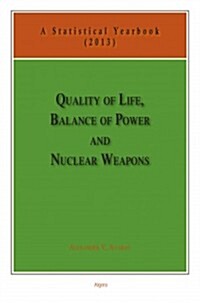
단행본
Quality of life, balance of power, and nuclear weapons: A Statistical Yearbook for Statesmen and Citizens
- 발행사항
- New York : Algora Pub, 2013
- 형태사항
- xi, 190 p.; 23 cm
- ISBN
- 9780875869636
- 청구기호
- 310.16 A945q
- 서지주기
- Includes bibliographical references (p. 189-190)
소장정보
| 위치 | 등록번호 | 청구기호 / 출력 | 상태 | 반납예정일 |
|---|---|---|---|---|
이용 가능 (1) | ||||
| 1자료실 | 00014614 | 대출가능 | - | |
이용 가능 (1)
- 등록번호
- 00014614
- 상태/반납예정일
- 대출가능
- -
- 위치/청구기호(출력)
- 1자료실
책 소개
Members of the US Congress and others who care about the foundations of power politics in the nuclear age will find facts that speak for themselves in this novel yearbook. This statistical annual presents fundamental data in four sections: (1) Quality of Life, (2) Balance of Power, (3) Developed Market Economies since 1960, and (4) Economic History since 1500. It contains data that is generally not available elsewhere. Sections 1 and 2 give statistics for 230 countries. The World Bank and Encyclopedia Britannica provide statistical data for a maximum of about 160 countries. The actual number of countries in World Bank statistical tables is even smaller. The CIA World Factbook gives data for about 230 countries but that data is limited in scope and is imprecise. Other statistical publications are even less satisfactory. The author has managed to increase the number of countries tallied by writing proprietary software utilizing statistical regressions, selecting data which, first of all, is important and, second, which allows for high correlation coefficients for these regressions. Section 2 includes data about nuclear delivery systems and the number of nuclear warheads of all nuclear powers. This is based on information from reputable sources. Among others, it includes estimates of the Israeli nuclear arsenal which usually do not appear in the press. Official estimates of Russian military expenditures distributed by US and British intelligence communities are methodologically flawed. Such estimates claim to give a picture of military expenditures of the countries of the world at market exchange rates; at the same time, they apparently cite Russian military expense figures at purchasing power parities, thus inflating these numbers in comparison to those of other countries. Such deceptive practices of the Anglo-American intelligence services are counter-balanced by presenting two different tables, showing military expenditures estimates both at market exchange rates and by purchasing power parities. Section 3 gives data on the topic of health care. It seems that public health expenditures as a share of total health expenditures has a stronger correlation with the comparative level (and the rates of improvement) of the main health care indicators than the absolute level (measured as a percent of GDP) of total health expenditures. The data demonstrates that the US has the lowest public health expenditure of developed market economies and is increasingly lagging behind other countries by main health care indicators. The proposed introduction of national health insurance in the US would probably mean some sort of tax increase. The author therefore also seeks to shed light on modern ideological debates about the share of taxation in GDP and its influence on rates of growth. Surprisingly enough, the empirical data for the developed market economies do not seem to support the popular idea that low taxes are strongly correlated with higher rates of growth; depending on how the data are analyzed, the appropriate correlations are either low or even the reverse of what is commonly believed. Section 4 primarily uses data which has become available through the groundbreaking works of Angus Maddison. Using interpolation techniques explained in that section to slightly adjust MaddisonA’s data, the author received numbers for population, GDP per capita, and total GDP for 48 countries for the period since year 1500, figures which seem to be credible and which are not readily available elsewhere.
